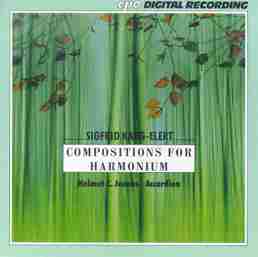 Helmut C. Jacobs, accordion
Helmut C. Jacobs, accordion

Program:
Partita op. 37 (1905)
Entrata
Courante
Sarabande
Bourrée et Musette
Air
Gavotte
Loure
Rigaudon
First Sonata op. 36 (1905)
Quasi Fantasia
Interludium
Finale/Fuga
Passacaglia op. 25 in E flat minor (1905)
Total time: 52:40
Released in 1990
Review Date: February 2000
Label: Classic Produktion Osnabrück
http://www.cpo.de (CPO 999 051-2)
Order from: AUGEMUS - Musikverlag
Ralf Kaupenjohann
Bleckstr.
1a
D-44809 Bochum
Germany
email: AUGEMUS@t-online.de
The first time I played Compositions for Harmonium, Helmut C. Jacobs' recording of music by German composer Sigfrid Karg-Elert, I was amazed at how perfectly the music and instrument seemed to fit together. I had listened to several of Karg-Elert's organ compositions in the past, and these had impressed me as craftsman-like and intelligent, although less demanding (and interesting) than the works of his friend and colleague, Max Reger. Based on this limited exposure, I had concluded he was simply a studious, post-Romantic academician. This single recording, however, totally changed my opinion of his abilities as a composer. Here, at last, I heard Karg-Elert in his element. The translucent colors of his compositions bloomed in the warm, vocal quality of free-reed tone!
Not since studying the music of François Couperin have I been aware of another composer who so thoroughly understood his instrument. Couperin's works share a symbiotic relationship with the French harpsichord and achieve their full expressive potential only when played upon that instrument. The same can be said of Karg-Elert's music for the kunstharmonium. [Please see Henry Doktorski's review of Sigfrid Karg-Elert: Harmonium Works Vol.'s 1, 2 & 3 for more information about this instrument.]
Having said that, I must then tell readers that Helmut Jacobs does not play the kunstharmonium but a chromatic free-bass accordion! The question that logically follows is, does this affect the quality of his interpretations? In my opinion, no! In his hands, the accordion has a range of expression that compares very favorably to the harmonium, and he demonstrates that his instrument is admirably suited to rendering Karg-Elert's music. While it may lack some of the mechanical gadgetry of the larger instrument, it makes up for deficiencies in both portability and availability. Considering the rarity of a genuine kunstharmonium (as opposed to the ubiquitous nineteenth century parlor organ), I think the free-bass accordion is an excellent and acceptable substitute.
The disc opens with the Partita op. 37, a quasi-Baroque keyboard suite. Here the composer explores antique musical models within the confines of his personal harmonic language. The result is music that is courtly without being contrived, quaint or precious. The eight movements recorded here (Jacobs omits one) are deceptively simple yet engaging enough to hold a sophisticated listener's interest. The artist impresses with his easy grace and elegant, yet unstuffy delivery.
Karg-Elert's First Sonata op. 36 is a work of more serious mettle. The opening movement, 'Quasi Fantasia,' owes its abstract structural freedom to organ toccatas of the North German Baroque. Bold chords dialogue with rhapsodic runs, and episodes of stressful chromaticism dissolve into momentary intervals of consonance. This is a musical struggle between contrasting elements! The quiet and expressive 'Interludium' that follows is almost a relief after so much angst. It forms a hymn-like passage to the third movement. The 'Finale, Fuga,' is a masterly double fugue, the subjects of which are very reminiscent of J. S. Bach. Such is the skill of the composer that even when one can identify the source of his inspiration, the way in which he develops his material is completely original. He breaks off his fugal writing and rounds out the piece by returning to the rhapsodic ending of the opening Fantasia.
The final and most impressive selection on this CD is the dark and stately Passacaglia in E-flat minor. It opens with an exceptionally long and angular theme played on the bass manual of the accordion. As these twenty-four bars of music solemnly unwind, they suggest the deep colors and complex contrapuntal textures we find in the variations that follow. Karg-Elert remains true to his somber harmonic scheme throughout this piece and still manages to exercise a generous pallet. Certainly, no other modern composer has employed melodic diminution so well and so expressively. His penultimate variation is a brief but glorious torrent of four-part polyphony, with triplet-rhythms superimposed over the theme in syncopation.
Throughout this recording, Helmut Jacobs plays with exceptional insight and skill. He is solidly in control of his instrument and his phrasing and articulation are neat without being fussy. Toward the end of the Passacaglia, however, there are a few awkward moments. When changing bellows direction in the middle of long phrases, he allows several fleeting lapses of tone. These are familiar technical hurdles for accordionists, but here the difficulties are more noticeable because Karg-Elert did not write for an instrument that must 'breathe.' The overall movement and thrust of the piece easily carry the listener over these few bumps.
Finally, the excellent work done by the German recording engineers deserves mention; they have struck a fine balance between room ambience and the stage-presence of Jacobs' accordion. Without doubt, the attributes that make this recording so desirable are Helmut Jacobs' admirable musicianship and Karg-Elert's wonderfully accessible compositions. This is a musical alloy that will delight and please; it has certainly held my interest over the several years that I have owned this compact disc.
| About The Free-Reed Review |
| Invitation to Contributors / Submission Guidelines |
| Back to The Free-Reed ReviewContents Page |
| Back to The Classical Free-Reed, Inc. Home Page |